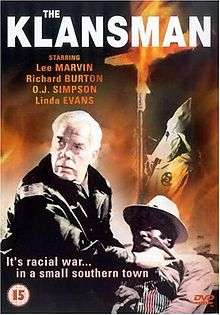The Klansman
| The Klansman | |
|---|---|
 | |
| Directed by | Terence Young |
| Produced by |
William D. Alexander Bill Travers |
| Written by |
William Bradford Huie (novel) Millard Kaufman Samuel Fuller (screenplay) |
| Starring |
Lee Marvin Richard Burton |
| Music by |
Stu Gardner Dale O. Warren |
| Cinematography | Lloyd Ahern |
| Edited by | Gene Milford |
| Distributed by | Paramount Pictures |
Release dates |
|
Running time | 112 min. |
| Language | English |
The Klansman is a 1974 American motion picture drama based on the book of the same name by William Bradford Huie. It was directed by Terence Young and starred Lee Marvin, Richard Burton, O.J. Simpson (in his feature film debut), Lola Falana and Linda Evans.
Plot
The Klansman recounts what happens to an African American man in a small town in the South after a young white woman (Linda Evans) is sexually assaulted and beaten. Events spiral out of control when a sniper shoots a Ku Klux Klan member at a funeral.
Cast
- Lee Marvin - Sheriff Track Bascomb
- Richard Burton - Breck Stancill
- Cameron Mitchell - Butt Cutt Cates
- O.J. Simpson - Garth
- Lola Falana - Loretta Sykes
- David Huddleston - Mayor Hardy Riddle
- Linda Evans - Nancy Poteet
- Luciana Paluzzi - Trixie
- David Ladd - Flagg
- John Alderson - Vernon Hodo
- John Pearce - Taggart
- Virgil Frye - Johnson
- Larry Williams - Lightning Rod
Production difficulties
Richard Burton allegedly drank so much alcohol during the making of this film that many of his scenes had to be shot with him seated or lying down, due to his inability to stand. In some scenes, he appears to slur his words or speak incoherently.[1]
During the location filming in a small town outside of Sacramento, the crew was based in a local motel. One motel room, next to the office, was filled with cases of alcohol, in rows, from floor to ceiling.
Burton, Marvin, et al., were dealing with personal issues off the set, as well as what seemed a difficult shoot; but, all were professionals, despite the quantity of alcohol consumption, and were always on time and ready with their lines.
Burton and Taylor were staying in a rented house. The crew passed around rumors of tension between them. As well as the big rumor among the crew, which concerned a shouting match (over a young girl from the town), which led them to throwing, first decor items, and then furniture at the walls of the house, which led to near complete destruction of the interior.
Burton gave a young girl in town a diamond ring and a small walk-on part in the film, which hit the national news, and which may have caused Taylor's visit and the altercation; but according to the crew, Burton was using the young girl as a cover for his real affair with a local married woman (with children) who was working on the location shoot. When the woman left her husband and children to meet him in LA, he had changed his mind and had decided to reunite with Taylor.
During one late night shoot, due to ongoing lighting issues, Burton wound up laying on the cold, damp ground for over an hour, with no protection under him and without an overcoat. Finally by 3 AM, after he had read and reread his line, over and over, and he was nearly frozen and completely exhausted, the 30 second scene was deemed properly lit. And that was the shot that was used in the film. After the last shot, he had to be lifted to his feet and wrapped in a blanket.
Aldo Tonti, the cinematographer who had worked with Mr Young on Reflections in a Golden Eye, was also the cinematographer on this film, though he was not credited.
The film's director, Terence Young, was best known for his work on the James Bond films. In a bit of stunt casting, he hired Luciana Paluzzi, who had played Bond villain Fiona Volpe in Thunderball, as Trixie in this film. The studio had American Joanna Moore dub in Paluzzi's lines.
See also
References
2. From notes & end of semester project presentation by film student who interned on location by invitation from the director, Terence Young.
External links
- The Klansman at the Internet Movie Database
- The Klansman is available for free download at the Internet Archive